Geistlich Biomaterials
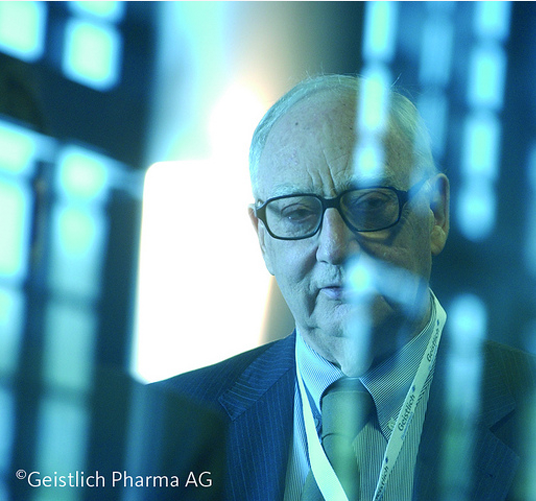
Geistlich Biomaterials Complete Solution Approach
With 160 years of production experience, Dr. Geistlich Biomaterials, which started production with the Bio-Oss product in 1986 under the leadership of Peter GEİSTLİCH, has been using biomaterials successfully as a bone substitute in oral bone regeneration in clinical studies for more than 20 years, more than 700 academic studies in more than 100 universities and thousands of patients with leading oral surgeons. In joint studies, Geistlich products have been tested and further developed for use in many different treatment options.
In the world;
– Applied to more than 7 million patients
– More than 700 academic studies
– 28 years of experience
Geistlich Biomaterials, one of the leading products in the world dental biomaterial market as of 2014, continues its sales in more than 50 countries and 5 continents
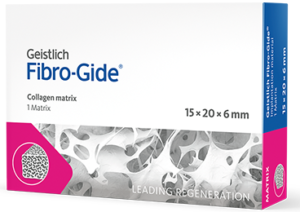
Geistlich Fibro-Gide® is a porcine, porous, resorbable and volume-stable collagen matrix, specifically designed for soft-tissue regeneration.1 The collagen matrix is made of reconstituted collagen and undergoes smart chemically cross-linking to improve its volume stability while maintaining a good biocompatibility.
The porous network of Geistlich Fibro-Gide® supports angiogenesis, formation of new connective tissue and stability of the collagen network in submerged healing.
In vivo animal models have shown good integration of Geistlich Fibro-Gide® into the surrounding soft-tissue while maintaining stability.
Geistlich Fibro-Gide® is the alternative to autogenous connective tissue grafts (CTG), which are considered as the gold standard in regenerative soft-tissue procedures.3,5,6 With Geistlich Fibro-Gide® additional harvest site is avoided, patient morbidity is reduced.
Inspired by Nature, engineered by Geistlich
The collagen expertise of Geistlich has led to a tailor-made product meeting the clinical needs and providing therapeutic solutions in oral soft-tissue regeneration. More than 1,000 prototypes were developed and tested in order to get a product like Geistlich Fibro-Gide®.11 Product availability may vary from country to country.

Geistlich Bio-Oss® Collagen consists of Geistlich Bio-Oss® cancellous bone granules and 10% highly purified animal collagen. Providing easy use, Geistlich Bio-Oss® Collagen carries all the bio-functional features of Geistlich Bio-Oss®.
The collagen in Geistlich Bio-Oss® Collagen resorbs within a few weeks, but it cannot replace the barrier feature provided by the membrane.
Geistlich Bio-Oss® Collagen: The versatile solution!
Geistlich Bio-Oss® Collagen can be used in all general implantology and periodontology indications. With its biofunctional properties and ease of use, Geistlich Bio-Oss® Collagen is also used in the treatment of fresh extraction sockets (socket protection and crest protection).
Geistlich Bio-Oss® Collagen is used for extraction sockets
After shooting, a large gap is created. The buccal bone level is also missing. In order to protect the three-dimensional volume (mucosal support), Geistlich Bio-Oss® Collagen is placed in the extraction socket as a block. Due to its material properties, Geistlich Bio-Oss® Collagen is also very easy to use.
Benefits of Bio-Oss® Collagen in application
– 90% of Geistlich Bio-Oss® Collagen consists of Geistlich Bio-Oss® granules.
– It is easy to apply and has impressive usage features. – During slow resorption, the volume of augmented tissue remains constant. 2,3,4
– It helps soft tissue aesthetics by increasing bone regeneration. 5
– Provides clinical improvement in pocket depth (PD) and clinical attachment level (CAL). 6.7
– Proven regeneration of the periodontal junction (bone, ligament, cementum) is seen in human histology samples.
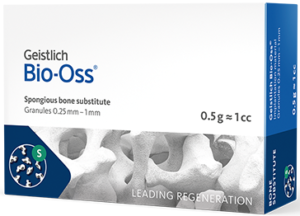
Geistlich Bio-Oss® has been successfully used as a bone substitute in oral bone regeneration in clinical studies for more than 20 years. In studies conducted jointly with more than 100 universities and leading oral surgeons, Geistlich Bio-Oss® has been tested and further developed for use in a wide variety of treatment options. More than 700 publications have documented the successful results of Geistlich Bio-Oss® and this number is constantly increasing.
Today, Geistlich Bio-Oss® is considered the standard substance used in bone regeneration.
Biofunctionality
Due to its close resemblance to human bone, Geistlich Bio-Oss® has become part of the natural shaping and reshaping process. The highly porous structure of Geistlich Bio-Oss® provides sufficient surface for the formation of blood vessels (angiogenesis) and helps bone formation (osteogenesis). The microstructure of the Geistlich Bio-Oss® surface supports the optimal development of osteoblasts that provide bone formation. Thus, Geistlich Bio-Oss® particles become an integral part of the newly forming bone. Geistlich Bio-Oss®’s slow conversion rate to autogenous bone (remodeling) ensures that the bone structure is stabilized and the growing volume of bone is durable for a long time. These biofunctional features make Geistlich Bio-Oss® unique.
Biofunctionality in Practice
Literature evidence describing predictable outcomes should be utilized in daily clinical practice. Geistlich Bio-Oss®, the inorganic bone matrix preferred and documented by the majority, provides long-term and successful augmentation results with volume preservation and ideal osseointegration, which will ensure the durability of the implant. Geistlich Bio-Oss® can also be placed on autogenous bone grafts, compensating for bone resorption with the help of its biofunctional properties.
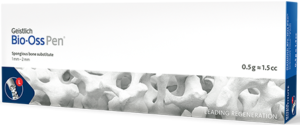
Geistlich Bio-Oss® granules are now ready for use in the Geistlich Bio-Oss Pen®.
Thanks to its applicator, its use is faster, easier and more efficient!
Geistlich Bio-Oss Pen® dimensions:
Fine granules (0.25mm-1mm) 0.5g ≈ 1.0cc
Thick granules (1mm-2mm) 0.5g ≈ 1.5cc
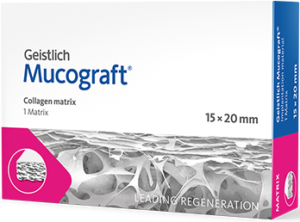
Minimum intervention, maximum soft tissue gain!
Geistlich Mucograft® is now at your disposal as a successful alternative to autogenous soft tissue graft. This new solution will provide great comfort to both you and your patients!
Geistlich Mucograft® naturally integrates with your patient’s own tissue and acts like a free gingival graft or connective tissue graft in the treatment of gingival recession and keratinized tissue regeneration.
Geistlich Mucograft® is a three-dimensional collagen matrix structure with high biocompatibility. This structure shortens the surgery time by eliminating the process of removing tissue from the patient. It also has advantages such as reducing the possibility of complications and reducing the pain felt by the patient.
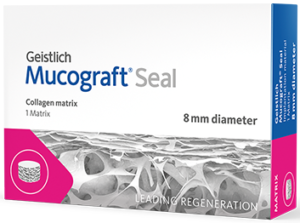
Seal The Deal!
Geistlich Mucograft Seal is produced as an alternative to autogenous soft tissue grafts. The technical rules of use of Geistlich Mucograft Seal were developed under the supervision of the Geistlich Mucograft Seal Advisory Board, which is a specially prepared consensus as well as 5 years of clinical experience. Here are the rules you should consider when using Geistlich Mucograft® Seal:
Geistlich Mucograft ® Seal must be used with an alveolar filling material. (e.g. Geistlich Bio-Oss ® Collagen)
Adjacent soft tissue margins must be de-epithelialized before applying Geistlich Mucograft® Seal. This carries the soft tissue cells that extend beyond the soft tissue border into the matrix. Geistlich Mucograft ® Seal must be adapted to the size of the defect and applied dry.
Geistlich Mucograft ® Seal Orientation: The compact structure of the matrix should face its small gap, and it should be placed on the side of the extraction socket with its spongy structure. The spongy structure of Geistlich Mucograft ® Seal is marked with grooves
Fixing the Geistlich Mucograft® Seal
Geistlich Mucograft ® Seal is sewn with non-absorbable suture material and is not glued. It can be fixed with single interruption, double interruption or cross stitching to ensure good adaptation of the product to the tissue margins.
The best possible suture material should be properly selected by the surgeon. For single interrupted suture, 5.0 or 6.0 suture is recommended. Stitch size 5.0 is suitable for cross stitches.
During the suturing of the Geistlich Mucograft® Seal, make sure that the extraction socket is closed without excessive tension on the de-epithelialized marginal soft tissue border edges.
For more information, please read the technical terms of use.
